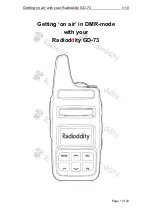
810-805
Handheld AM/FM/Weather Band
NOAA Weather Radio
The La Crosse™ handheld NOAA weather radio helps you stay aware
of weather events while at home or on the go. Portable size is great
for camping, hiking or boating. Listen to your choice of 7 different
weather band channels for up-to-the-minute weather information and
alerts or AM/FM radio. The radio also features an integrated LED
flashlight for your convenience.
FEATURES:
Weather Band:
Receives 7 weather band channels.
Radio:
AM and FM radio reception.
Battery:
3 x AA LR6 Alkaline batteries.
Light:
LED flashlight at the push of a button.
Backlight:
Blue changes to Red for Weather Alert.
Lanyard:
Lanyard for easy carrying (included)
OPERATION
battery or optional A/C power (sold separately)
:
Battery operation:
Important: Do not mix old and new batteries.
Do not mix alkaline, standard, or rechargeable batteries.
Remove battery cover from back of radio.
Install 3 x AA LR6 alkaline batteries.
Replace battery cover.
Turn radio on, select mode and station, adjust volume, enjoy!
Optional A/C operation:
Plug in a 6.0V adapter (not included) into the wall outlet
and into the AC/DC power port on the side of the radio.
A/C adapter purchase info: www.lacrosseclock.com/810-805
Turn radio on, select mode and station, adjust volume, enjoy!
ON/OFF
:
Press and release the ON/OFF button on the right side of the radio to
turn the radio ON or OFF.
Note:
Default volume will be level 6 when the radio is first turned on.
Radio will memorize the last radio mode (AM, FM or WB)
and the last channel/station.
Backlight will turn on for 10 seconds.
RADIO MODE
:
With the radio ON, press and release the MODE button on the left
side to toggle between these radio modes:
AM radio
FM radio
WB radio
Note
: When in WB mode hold the MODE button for 2 seconds to
enter WB standby (mute) mode.
TELESCOPING ANTENNA:
For AM/FM and weather band radio, fully extend the telescoping
antenna to receive a steady strong signal. Place the radio near a
window if you are indoors for best reception.
WEATHER BAND RADIO:
The IC Chip supports weather band reception from 162.4 to 162.55
MHz. The highly integrated IC Chip meets NOAA specification,
receives all seven NOAA specified frequencies, implements
narrowband FM de-emphasis, and supports 1050 Hz alert tone
detection. In addition, the IC Chip provides advanced features not
available on conventional radios, such as an AFC and a dynamic
channel bandwidth filter. In WB mode the radio will continually
broadcasts weather radio. Fully extend telescoping antenna.
Radio receives 7 weather band (WB) frequencies:
Channel 1: 162.400MHz
Channel 5:
162.500MHz
Channel 2:
162.425MHz
Channel 6:
162.525MHz
Channel 3:
162.450MHz
Channel 7:
162.550MHz
Channel 4:
162.475MHz
STANDBY:
When in WB hold the MODE button for 2 seconds to enter WB
Standby. When in Standby the red LED on top of the radio will flash
slowly (every 5 seconds).
ALERTS
:
The radio must be in WB mode to receive alerts automatically.
During an alert:
The top LED light and red LCD backlight will flash quickly
(every 2 seconds) for 5 minutes.
The volume will increase to level 16 for 5 minutes so you
can hear the beep alert tone and the broadcast. Use the
VOLUME buttons to adjust as needed.
While alert is sounding for 5 minutes, press and release the
MODE button to place radio back to WB standby.
Radio automatically returns to WB standby after 5 minutes.
AM RADIO:
The highly integrated IC Chip supports worldwide AM band reception
from 520 to 1710 kHz using a digital low-IF architecture with a
minimum number of external components and no manual alignment
required. This digital low-IF architecture allows for high-precision
filtering offering excellent selectivity and SNR with minimum variation
across the AM band.




















